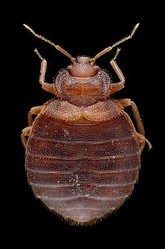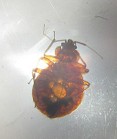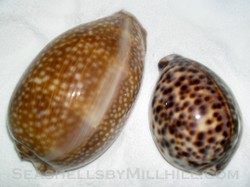
How to Treat Bed Bugs
by missheather
Article focused on getting rid of bed bugs in homes, apartment buildings, and other places that house transient guests.
How to Treat a Bed Bug Infestation
- Everything related to treating for bed bugs
The phrase "Good night, don't let the bed bugs bite" used to be primarily used as a joke, but recently it has been more true than ever as there has been a spike in the number of bed bug infestations. It is happening in hotels, motels, homeless shelters, homes, and even apartment complexes and there is little you can do to prevent a bed bug infestation. Since there are practically no preventative measures for bed bugs, the most important thing you can do is educate yourself on them. This article will discuss how bed bugs are spread and the various methods for getting rid of them.
How Bed Bugs are Spread
First, let's discuss how bed bugs are transferred and infestations begin. For starters, it is worth mentioning that bed bugs are transported from one place to another by way of human, animal, or other stationary objects brought into the environment. In other words, these bugs are transported via personal clothing, pets, or people visiting from infested locations. In less common occurrences and in heavy infestations, it is said that bed bugs travel through false ceilings and duct work.
Where to Look for Bed Bugs
With that said, once you have one bed bug it is only a matter of time until there are more. At this point it is important to locate each area bed bugs are present. For example, common places to look is where the ceiling and walls meet, around the seam of all mattresses, behind pictures and other wall mountings, and even near baseboards on the floor. However, it is not uncommon to find them in chairs and other pieces of furniture, as well as inside the walls and electrical outlet.
Using Trained Dogs to Locate Bed Bugs
One thing is for sure, and that is the fact bed bugs are nocturnal and do not like to be subjected to bright lights. For these reasons, they tend to hide in the smallest cracks and crevices they can find in which all sides of its body is being touched and it feels very safe. So, in terms of detection the best detector of a bed bug is actually a dog. In fact it is said that trained humans only have a 13% success rate in diagnosing bed bug infestations; however, on the other hand, a trained canine has a 97.5% success rate in locating them. These dogs undergo extensive training that covers thousands of hours and will ensure a trained dog can locate ONE bed bug in the middle of a football field. Basically, these dogs are trained to show interest in all types of bed bugs, but they are trained to make a huge deal out of locating non-chemically treated bed bugs that are alive. In other words, if there are traces of dead bed bugs that have died from heat or chemicals, the dog will alert but it will not be the same "alert" as an ongoing infestation.
These dogs are able to do so because their sense of smell is so much more heightened than a human's sense of smell. Hence, they can smell the pheromones given off by the bed bug which makes them effective at locating infestations.
Treatment Methods for Bed Bugs
Once an infestation has been located, you will have a few options in terms of eradicating them. The first option is to contact a commercial or local pest control company who will have the correct chemicals useful in killing the bugs. Companies such as Orkin or Truly Nolen are able to complete a two part chemical system which they guarantee for 30 days and costs roughly $450 per room. The only problem with this system is that the bugs must come in contact with the chemical in order for it to work. Thus, if the bugs are not travelling very much or the pest control experts did not properly apply the chemical, the system may not be effective.
The other popular option for ridding an area of bed bugs is trough thermal remediation. This system is very interesting and has a much higher success rate than the chemical treatment; however, it does cost a considerable amount more at about $1000 per treatment area. This system works by bringing in a generator, large space heaters, and high pressure fans that basically heats the room up to about 120 - 135 degrees in order to coax the bed bugs into coming out of hiding and then smoldering them to death. In addition to being harmed by chemicals, these bugs also cannot withstand the heat so thermal remediation can actually be a very safe, effective way of handling bed bugs. However, it is worth mentioning that the heat treatment is not always 100% effective the first time either because sometimes the temperature does not rise quickly enough which allows the bugs time to run and find a safe hiding spot. Essentially though, this process works best because the bugs are usually tricked by the heat as they think a large meal has entered the room, in reality it is just enough hot air to kill them. As the room is heated up, there are wireless monitoring devices placed around the room so the heat levels of the area can be safely monitored from a secondary location.
In conclusion, regardless which system you choose neither are 100% guaranteed to be effective because bed bugs can be very difficult to rid. Each system is sure to come with some short-term guarantee of perhaps 30 days or less. Warranty periods of longer than 30 days are rarely to never available because bed bugs can be brought back in the next day (although that is highly unlikely in your own home). The main things to remember is that if you know someone has a bed bug infestation beware of letting them bring items into your home as they could be leaving you a nice blood-sucking surprise behind. Other than that, be conscious and careful of where you get furniture from as it is common for bed bugs to infest pieces of furniture; in addition to checking hotel rooms before you bring your belongings in. In the end, just be educated and prepared which are the two most important things in terms of getting rid of bed bugs.
For more information check out Bed Bug Advisor
Books on Bed Bugs
Brought to you by Amazon.com
Bed Bugs on Wikipedia
Have you or anyone you know had bed bugs?
Finding Bed Bugs
How to locate a Bed Bug Infestation
You might also like
How To Find Due South Using the Sun at Any Time of DayThis is one of many forms of navigation that doesn't require gadgets. And onc...
STEM Subjects and EducationSTEM stands for science, technology, engineering, and mathematics. There are...
Collecting Seashells: Types of ShellsA look at some seashells you may see on Florida beaches with photos of my own...










 Potty Training a Boxer Puppyon 05/29/2012
Potty Training a Boxer Puppyon 05/29/2012
 English Bulldogson 05/24/2012
English Bulldogson 05/24/2012
 Marc Jacobson 05/16/2012
Marc Jacobson 05/16/2012
 Reasons to Buy Dyson Vacuum Cleanerson 05/16/2012
Reasons to Buy Dyson Vacuum Cleanerson 05/16/2012




Comments